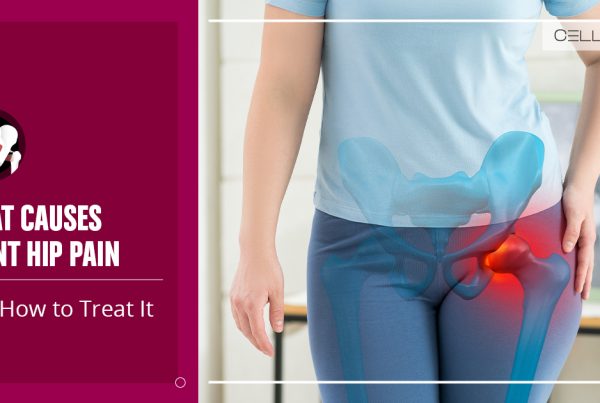Published on: April 12, 2024 | Updated on: January 18, 2025
It’s pretty alarming when you suddenly feel like your legs are going to give out. Whether you’re standing, walking, or even just sitting down, this sensation can really take you by surprise.
But why does it happen, and what exactly is going on in our bodies when we experience this? In some cases, the weakness in your legs is due to a recent injury, while in others, there’s a deeper underlying issue.
Below, we discuss the causes of this feeling. We also talk about potential treatment strategies to help you get back on your feet.
Reasons Your Legs Feel Like They Are Going To Give Out

Some reasons for leg weakness are acute, while others are chronic. It’s crucial to seek due medical attention as soon as possible to prevent further complications. Some common causes of sudden leak weakness are the following.
Radiculopathy
Radiculopathy is a condition that affects the nerve roots in your spine. It can cause compression, inflammation, or damage to these nerves, resulting in pain and numbness.
The human spine is made of several bones called vertebrae. Your spinal cord runs through a canal formed by these vertebrae. The nerve roots branching out of your spinal cord exit the spine in different places. Any damage to these nerves can result in symptoms that we collectively call radiculopathy.
Symptoms of radiculopathy include:
- Sharp pain in legs, shoulders, arms, and back
- Weakness of legs and arms
- Loss of reflexes in legs and arms
- Pins and needles or tingling sensation in legs, arms, and back
How radiculopathy affects your leg muscles will depend on the severity of nerve damage and the location of the affected nerve roots. You have difficulty in:
- Lifting your foot
- Lifting your leg
- Maintaining balance
- Walking straight
The treatment of radiating pain will depend on the underlying cause. In some cases, nonsteroidal anti-inflammatory drugs are prescribed. Your doctor may also recommend physical therapy, weight loss strategies, or steroid injections to manage the pain and inflammation.
Diabetic Neuropathy
Diabetes may damage nerves throughout the body, mainly affecting the feet and legs. The condition is called diabetic neuropathy.
People suffering from diabetic neuropathy have weaker muscles and reduced blood supply to the affected nerves. Some other symptoms are:
- Ankle and leg weakness
- Unsteady gait
- Loss of balance
- Sharp leg pain
- Loss of sensation in the feet and legs
- Numbness in the legs
Upon diagnosis, your healthcare provider would recommend special shoe inserts, special footwear, and medications to relieve pain and improve mobility.
Stroke
Although a stroke mainly affects the brain, it can also cause damage to leg muscles. When your brain’s blood supply is cut off, the neurons begin to die, leading to loss of movement control in different parts of the body, including the legs.
Besides leg weakness, you may experience the following symptoms:
- Severe headaches
- Sudden confusion
- Difficulty speaking
- Difficulty walking or balancing
- Numbness in your legs, arms, or face on one side of your body
- Drooping on one side of your face
It’s imperative to call for help immediately if you experience these symptoms. Treatment methods for stroke will depend on the type and severity of the stroke.
They range from medication and surgical clipping to carotid endarterectomy and angioplasty or stents.
Cauda Equina Syndrome
While rare, the Cauda Equina syndrome is a severe condition that affects the lower part of the spine. In this condition, the cauda equina (a bundle of nerves at the bottom of the spinal cord) is compressed, causing severe pain and weakness in the legs along with other symptoms.
Some causes of Cauda Equina syndrome include:
- Herniated disc
- Birth abnormalities
- Spinal anesthesia
- Spinal infections
- Lumbar spinal stenosis
- Spinal tumors or lesions
Feeling like your legs are giving away is just one symptom of Cauda Equina syndrome. Other symptoms include:
- Urinary retention
- Fecal and urinary incontinence
- Weakness or numbness in the legs
- Sexual dysfunction
- Lack of bladder control
- Numbness in genitals, inner thighs, and groin
- Sciatica (pain in the legs or back)
The most used treatment for Cauda Equina syndrome is surgery, which involves decompressing the affected nerves. The surgeon may also remove any underlying cause of compression, such as tumors or lesions.
Central Canal Stenosis
Central canal stenosis occurs when the spinal canal, which is the central space in your spine that contains the spinal cord, narrows. The canal may narrow in the upper back, lower back, or neck.
Causes of central canal stenosis include:
- Tumors growing into the spine
- Trauma (eg. bleeding)
- Bone spurs
- Spine ligament thickening
- Disc herniation
With less blood flow to the spinal cord, your legs may become less stable. The common symptom of central canal stenosis is weakness of the legs. Besides, you may experience:
- Pain on walking long distances
- Loss of balance
- Difficulty walking
There are surgical and non-surgical treatments for central canal stenosis. Non-surgical treatment options include:
- Physical therapy to improve strength and stability in the legs
- Medications such as nonsteroidal anti-inflammatory drugs (NSAIDs) to reduce pain and inflammation
- Corticosteroid injections into the spinal canal to reduce inflammation
However, if the condition has a severity of over 30%, combined with notable leg weakness, surgical methods are required.
Alternative Treatments for Sudden Leg Weakness: Orthobiological Approach
In some instances, especially when there’s persistent leg weakness, you might opt for orthobiological treatment. At CELLAXYS, board-certified surgeons offer various orthobiological treatments that focus on maximizing the body’s regenerative potential. These treatments include:
- Platelet-rich Plasma (PRP) Therapy: PRP is a quick, 45-minute, non-surgical treatment that involves injecting a concentrated amount of your own platelets into the affected area. These platelets contain growth factors and other healing proteins that help repair damaged tissues and stimulate new tissue growth.
- Cell-based Therapies: In this treatment, a small amount of your bone marrow or adipose tissue is collected and processed to obtain a concentration of cells that promote healing and regeneration. We offer Minimally Manipulate Adipose Tissue Transplant (MMAT) and Bone Marrow Aspirate Concentrate (BMAC) therapies for our patients.
Cell-based and PRP approaches are minimally invasive, safe, and have a short recovery period. Plus, they’re outpatient. So, you can go home the same day. Give these treatments a try if you’re looking for an alternative to surgery.
Sources
Footnotes
- Alam U, Riley DR, Jugdey RS, et al. Diabetic neuropathy and gait: A review. Diabetes Therapy. 2017;8(6):1253-1264.
- Lavy C, Marks P, Katerina Dangas, Todd NV. Cauda equina syndrome—a practical guide to definition and classification. International Orthopaedics. 2021;46(2):165-169.
- Raja A, Hoang S, Patel P, Mesfin FB. Spinal stenosis. Nih.gov. 2023.
References
- Radiculopathy. Hopkins Medicine. Accessed 11/12/2023.
- Radiculopathy. Cleveland Clinic. Accessed 11/12/2023.
- Diabetic Neuropathy. Hopkins Medicine. Accessed 11/12/2023.
- Stroke Signs and Symptoms. CDC. Accessed 11/12/2023.
- Stroke – Diagnosis and Treatment. Mayo Clinic. Accessed 11/12/2023.
- Cauda Equina Syndrome. AANS. Accessed 11/12/2023.
CELLAXYS does not offer Stem Cell Therapy as a cure for any medical condition. No statements or treatments presented by Cellaxys have been evaluated or approved by the Food and Drug Administration (FDA). This site contains no medical advice. All statements and opinions are provided for educational and informational purposes only.
Dr Pejman Bady
Author
Dr. Pejman Bady began his career over 20 years ago in Family/Emergency Medicine, working in fast-paced emergency departments in Nevada and Kansas. He has served the people of Las Vegas as a physician for over two decades. Throughout this time, he has been met with much acclaim and is now the head of Emergency Medical Services in Nye County, Nevada. More about the doctor on this page.
Dr Pouya Mohajer
Contributor
Pouya Mohajer, M.D. is the Director of Spine and Interventional Medicine for CELLAXYS: Age, Regenerative, and Interventional Medicine Centers. He has over 20 years of experience in pain management, perioperative medicine, and anesthesiology. Dr. Mohajer founded and is the Medical Director of Southern Nevada Pain Specialists and PRIMMED Clinics. He has dedicated his career to surgical innovation and scientific advancement. More about the doctor on this page.









